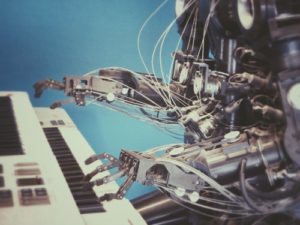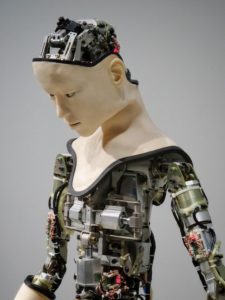The post Differences Between AI And Machine Learning appeared first on Magnimind Academy.
]]>Before we dig into the topic deeper, let’s have a quick look at the definitions of AI and machine learning.
1- What’s AI?

The term “AI” is exceptionally broad in its scope. It can be defined as the theory and development of computer systems that are capable of performing tasks that generally require human intelligence like speech recognition, decision making, visual perception, among others.
2- What’s machine learning?

Machine learning is a subset of AI in the computer science field that uses statistical techniques to enable the computers to learn with the help of data, without being programmed explicitly. It provides the systems with the ability to learn automatically and improve from experience.
3- The rise of AI

It’s needless to say that both AI and machine learning are relatively newer concepts. Though AI stretches its origin back to certain imaginative people from decades or even centuries ago, it’s only recently when it has become a reality. In the past, early computers were considered by engineers as mechanical brains and logical machines since they were capable of producing memory and arithmetic. Along with the advancements in technology, the concept of AI has been changed. Put simply, AI encompasses and mimics the decision making ability of humans to perform complicated tasks in a more human-like manner. It’s a much wider concept than machine learning. Let’s see the tasks that are performed by AI-enabled systems, in general.
- Problem-solving
- Planning
- Recognizing images and voices
- Understanding languages
- Learning
- Performing other “smart” tasks
Types of AI
There’re two key subcategories of AI. The first is applied AI while the second one is general AI.

Applied AI is focused on predefined tasks. It doesn’t hold any consciousness and unseen tasks can’t be generalized by it. It’s much more common in real world and examples of its implementation can be easily observed. Some of the applied AI systems include Siri, Netflix recommendations etc.

General AI holds all the capabilities of applied AI together with all the characteristics of human intelligence. It’s less common as it’s more complicated to create. Ideally, general AI systems should be able to perform any intellectual task successfully that can be done by humans. It’s important to note that this subcategory is what led to the rise of machine learning.
4- Rise of machine learning

There’re certain breakthroughs in the field of AI that contributed heavily in the development of machine learning. The first one involved identifying that it’s more effective to teach computers how to learn compared to teach them how to perform each possible task and provide them with the information needed to perform those tasks. Invention of the internet is the second major breakthrough that led to a huge potential of information storage. Now, machines can access massive amounts of data that they had never been able to access earlier because of storage limitations.
Put simply, machine learning can be considered as the practice of utilizing algorithms to parse data, obtain knowledge from it, and then make a prediction or determination about something. So, instead of hand-coding software practices with a certain set of instructions to perform a specific task, the machine becomes trained by using massive amounts of data and algorithms that enable it to learn how to perform that task thanks to data science training. Immersive data science experience is a comprehensive step for machine learning.
With machine learning coming from the AI landscape directly, several algorithmic approaches are there that are being used heavily. Some of these include Bayesian networks, reinforcement learning, decision tree learning, clustering, and inductive logic programming, among others.
5- Neural networks are there too

Neural networks play an essential role in the process of teaching computers human-like thinking. They allow computers to mimic human brains more closely while being more accurate, faster and less biased. Accessed data is used by neural networks to make determinations. The feedback loop for learning involved in these networks enables a machine to find out whether its decisions are right or not, and to change its approach accordingly in order to perform better the next time.
6- Limitations of AI

Though AI is revolutionizing the way companies do business, it comes with some real limitations too. So, it’s crucial to understand them before you go ahead with the implementation of AI. Here’re some key limitations to effective implementation of AI.
- Data: Data is crucial for AI-enabled systems to do their job. The problem is: in most companies, data is siloed typically, and rarely catalogued consistently and maintained. Often, companies refrain themselves from working with AI because they think that they mayn’t have adequate amount of required data. They also often overlook the fact that it’s about having actionable data and not general data. Data standards and regulations are two other data-related limitations.
- Inability to think for itself: AI-enabled systems can only do what they’re programmed to do. It’s not capable of making split-second judgments like a human being. So, precise management and control of these systems are extremely crucial.
- Lack of real-world knowledge: AI-enabled machines usually don’t understand what they don’t understand. Though they can interpret huge volumes of information, it can’t be ensured that they will understand everything about them.
- Cost and maintenance: AI-enabled systems come at a significant price and their ongoing maintenance is costly too. The software needs to be updated regularly to adapt to the continuously changing business landscape.
Despite all these limitations, AI is surely going to be more and more efficient over time. However, you should consider these aspects in order to stay away from unrealistic expectations.
7- Limitations of machine learning

Machine learning also comes with its own limitations. Machine learning models are much more complex in nature. Though these models are capable of making predictions and recommendations by identifying patterns in a given dataset at a scale beyond the limits of humans, it’s impossible to explain how and/or why the model has made those predictions and recommendations. This lack of transparency is a key issue in some industries.
8- Differences between AI and machine learning in a nutshell
Here’s a brief overview of what we discussed earlier in this post in order to determine the key differences between AI and machine learning.
- Goal of AI is to increase chances of success instead of accuracy while machine learning aims at increased accuracy rather than focusing on success
- Natural intelligence is stimulated in AI to solve complex problems while machine learning models learn from given data on specific tasks to optimize their performance
- Unlike machine learning that allows systems to learn from data, AI encompasses decision making
- AI involves developing systems that can mimic humans while machine learning involves developing self learning algorithms
- Unlike machine learning that leads to knowledge, AI focuses on intelligence
9- AI or machine learning – Which one should you go for?

Both AI and machine learning have a lot to offer with their promises of giving creative insights as well as automating mundane tasks. Industries in every field – from healthcare to banking to manufacturing and more – are gearing up to reap the benefits if they aren’t already.
While AI has been around for a prolonged time and can sometime seem like an “old hat”, machine learning can offer businesses something new. Today, we’re certainly closer than ever and we’re moving toward developing human-like AI at an increasing speed. It’s important to understand that much of the enviable progress happening in the recent years is heavily based on the fundamental changes in the way we envisage AI working that has been brought about by machine learning.
Both these systems already offer some great applications and we can expect to see more to come from them. However, machine learning has gotten more publicity lately with a huge number of companies focusing on this source of solutions. AI can also prove to be extremely useful for an array of simpler applications that don’t need ongoing learning.
Despite all the differences, the huge majority of AI solutions are machine learning solutions. You can strategically use both AI and machine learning to maximize your benefit. In the future, it might be possible for machine learning to lead us to something more predictable and more sophisticated. You can consider it as a distinct method of attaining the same goal as that of AI.
There’re various elements that have helped in increasing the wide adoption of and excitement around artificial intelligence. Among them, advanced artificial intelligence that is being used by companies is a variant of machine learning to a good extent.
As you can see from the above, there’re differences between AI and machine learning with something in common as well. When it comes to implementation, determining which one of these is best for your business depends on your field of business and your specific requirements.
. . .
To learn more about artificial intelligence, click here and read our another article.
The post Differences Between AI And Machine Learning appeared first on Magnimind Academy.
]]>The post 10 Powerful Examples Of AI Applications In Today’s World appeared first on Magnimind Academy.
]]>1- Automated customer support

Today, you’d hardly find a good online store that doesn’t offer at least one form of high-tech customer support, apart from the traditional support channel that can be reached via email or phone. Traditional support channels cost businesses a whooping amount of money and wastage of human resources that can be directed toward more intelligent and creative tasks otherwise. AI-enabled customer assistants can answer simple questions like letting you know the status of your order, and helping you in finding a particular product based on your description, among others. Online shopping experience has been greatly enhanced by chatbots because of the following reasons:
- They increase user retention by sending reminders and notifications
- They offer instant answers compared to human assistants, thus reducing response time
- Chatbots provide upselling opportunities through personalized approach
2- Personalized shopping experience

The online shopping platform you use collects and stores lots of information about your usage – whether you like it or not. Google Analytics alone is capable of providing the online store with information like your location, your browser, device etc, apart from how much time you spend on each page. Implementation of artificial intelligence makes it possible for online stores to use the smallest piece of data about every followed link or hover to personalize your experience on a deeper level. This personalization results into timely alerts, messages, visuals that should be particularly interesting to you, and dynamic content that modifies according to users’ demand and supply. Online stores can also change currency and interface automatically, send notifications about discounts on best-selling products, and offer time limits on desirable items.
3- Healthcare

In healthcare, artificial intelligence has already proved to be a game-changer, improving every part of the industry virtually. From safeguarding patients’ personal records against cybercriminals to assisting in surgeries – AI is implemented everywhere. We all know that healthcare has suffered from inefficient processes and skyrocketing medical costs for long. AI is offering the industry a much-needed makeover. AI-enabled workflow assistants are aiding doctors free up their schedules, reducing time and cost by streamlining processes and opening up new avenues for the industry. In addition, AI-powered technology helps pathologists in analyzing tissue samples and thus, in turn, making more accurate diagnosis.
4- Finance

Collaboration of finance industry and artificial intelligence is a perfect match. The financial sector heavily relies on real-time reporting, accuracy, and processing of large volumes of quantitative data to make crucial decisions. All these are areas in which AI-enabled systems excel. Because of the accuracy and efficiency of artificial intelligence, finance sector is quickly implementing machine learning, algorithmic trading, adaptive intelligence, chatbots, automation etc into an array of processes. Now, there’re automated advisors powered by AI, who’re capable of predicting the best portfolio or stock based on preferences by scanning the market data. Actionable reports based on relevant financial data is also being generated by scanning millions of key data points, thus saving analysts numerous hours of work.
5- Smart cars and drones

When it comes to AI applications, you can hardly get a more prominent and better demonstration of the technology than what smart cars as well as drone manufacturers are accomplishing with it. Big names like Walmart and Amazon are already investing heavily in drone delivery programs and it’s likely to become prevalent soon.
Autonomous vehicles are prime examples of how artificial intelligence is impacting the automotive industry. A large segment of autonomous vehicles are connected and thus, able to share the learning with each other. This percentage is set to increase rapidly in the future. With autonomous vehicles running on the roads and autonomous drones delivering the shipments, a significant amount of transportation and service related issues can be resolved faster and more effectively.
6- Travel and navigation

In both travel and transportation industries, AI is steadily becoming one of the key tools for service providers as well as users. From suggesting efficient route to home, to making travel arrangements – artificial intelligence is helping people in taking the big leap. Travel companies, in particular, are capitalizing the ubiquitous usage of smart devices.

A huge percentage of users review travel tips, research local landmarks and dining options, and book trips on these devices, with the help of AI-powered travel assistants. Chatbots are also changing the travel industry rapidly by facilitating human-like interaction with consumers for travel recommendations, better booking prices, and faster response times. When it comes to transportation, you can consider Google Maps. With AI-enabled mapping, it scans road information and utilizes algorithms to identify the optimal route to take, be it in a bike, car, bus, train, or on foot. Al is every where that can be business, education and event space etc.
7- Social media

If you’re thinking that emergence of autonomous vehicles isn’t having any impact on you personally as they’re not in your city yet, how about something without using which your day doesn’t end? Yes, we’re talking about social media. If Facebook isn’t your thing, maybe it’s Twitter or Snapchat or Instagram or any of the other available social media apps. The fact is, when you’re using social media, a majority of your decisions are being influenced by artificial intelligence.
From notifications that you receive to feeds that you see in the timeline, everything is curated by AI. It considers all your past web searches, interactions, behaviors, and everything else done by you during your visit to these websites, and tailors your experience according to that. The role of artificial intelligence becomes even more important when the amount of content increases in the platforms since then, it becomes even more difficult to show users accurate information while fighting spam and improving user experience. In such cases, AI can act as a great boon.
8- Smart home devices

Rise of AI has exceptionally solidified the term “smart home”. A significant number of smart home devices that you buy use AI to learn your behavior so that they can adjust their settings automatically to make your experience as frictionless as possible. These smart home devices are controlled by using smart voice assistants, which are prime examples of AI. These techniques are part of our lives thanks to data science. While it’s true that it’ll take a significant time for us to see a perfect AI-powered home capable of reacting to our choices in real-lives, steps are already being made to bring this to the real world. Already, there’re smart lights that can change intensity and color based on time, and thermostats that can adjust the temperature based on user preference, among others.
9- Creative arts

AI-powered technologies are inspiring new songs now. Based on inputs gathered from millions of newspaper headlines, conversations, and speeches, insights are gleaned that can help musicians create themes. For instance, Watson BEAT is capable of coming up with different musical elements to help composers. By leveraging the power of artificial intelligence, musicians can understand what their audiences want and thus, compose songs based on that.
Another great example of the technology’s power is IBM’s AI-enabled Chef Watson who’s capable of becoming a sous-chef in your kitchen by helping you to develop recipes and advising on food combinations.
10- Security and surveillance

While you may argue on the ethical aspect of implementing a broad surveillance system, you can’t deny the fact that it’s being implemented. And artificial intelligence is playing a crucial role in this domain. It’s just impossible for humans to constantly monitor multiple channels with feeds coming in from a huge number of cameras at the same time, but AI is making that possible. Technologies like facial recognition and voice recognition are getting better with each passing day. Though there’s still some time before we can see that AI is monitoring all the security camera feeds, this is most likely going to happen sometime in the future. Image processing technology utilize the data science by raising the artificial intelligence.
Final note
Apart from these applications, there’re many others like AI-powered robots capable of thinking and solving problems in a limited capacity, increasingly adopted AI-powered marketing tools that can help marketers generate in-depth customer insights reports, book more impactful business meetings, and create pertinent content, among others. And all these are being done with minimal human intervention.

As you can see from the above examples, artificial intelligence is impacting human lives and the society through a diverse range of applications. Our choices are also getting influenced by it to a good extent. Several opportunities based on AI have already risen and we can only expect them to increase in the future. However, it’s crucial to address the issues that may act as obstacles for the wider adoption of this technology because solidifying society’s trust on it is crucial. Factors like convenience, speed, accuracy, assurance, and experience are hugely important for any technology to receive wider acceptance, and artificial intelligence is no different.
. . .
To learn more about artificial intelligence, click here and read our another article.
The post 10 Powerful Examples Of AI Applications In Today’s World appeared first on Magnimind Academy.
]]>